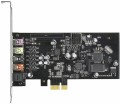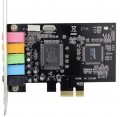Features
—
Ordinary. This category includes all sound cards that do not have a pronounced specialization and do not belong to any of the types described below. Usually, they have a set of characteristics of an entry-level or intermediate level and are designed for simple everyday tasks: listening to music and game sound through ordinary speakers or headphones, communicating on the Web through a microphone, etc. Conventional sound cards are equipped with both digital-to-analogue and analogue-to-digital converters, they can be either internal or external.
—
Audiophile (Hi-Fi). Sound cards designed for lovers of high-quality sound; they can also be useful for professionals who are engaged in professional audio processing and need the most accurate reproduction of the received signal. Accordingly, models of this type are distinguished by high build quality, advanced components, as well as the presence of additional equipment, an abundance of interfaces and advanced customization options (both software and hardware, including even the ability to replace individual circuit components). However, these cards cost accordingly.
—
Gamer's. Sound cards originally designed as components for advanced gaming systems. Accordingly, the main purpose of such models is high-quality transmission of game sound, including three-dimensional and multichannel. Typically, gaming audio ca
...rds are equipped with advanced DACs and support various special standards (see below); in addition, they may have additional equipment such as remote control modules (see below). The vast majority of models of this type are made internal, but they often have a rather original design (which is useful for modding enthusiasts who use transparent cases).
— CAP. Abbreviation for "Digital to Analogue Converter". Usually, this term refers to the constituent element of a sound card, but in this case it refers to a separate type of audio cards, the distinguishing feature of which is the absence of an analogue-to-digital converter (ADC). Accordingly, DACs are only capable of transmitting sound from a computer to headphones, speakers, etc., and cannot be used to digitize sound from a microphone or other external signal source. Note that this category includes a variety of models — from the simplest USB-headphone adapters, the size of a flash drive, to advanced audiophile-class solutions.
— Audio interface. A kind of opposite to the DAC described above: audio interfaces are designed primarily to digitize the sound coming to the input (for example, from a microphone or an electric guitar). Accordingly, they are not only necessarily equipped with analogue-to-digital converters — usually, these ADCs have very advanced characteristics and extensive sound tuning capabilities (and in some models even hardware switches are provided for this). At the same time, audio interfaces can also work in the digital-to-analogue audio conversion mode (in other words, to output sound to headphones/speakers). The cost of such devices is usually quite high, so it makes sense to purchase them only for those who plan to work a lot with sound recording.Audiochip
Brand of the audio chip installed in the sound card.
The audio chip is one of the most important parts of a sound card, a kind of "heart" of the whole circuit, and it is on its characteristics that the sound quality and other capabilities of a particular model largely depend. Knowing the brand of the chip, you can easily find various information on it — official specifications, test results, reviews, etc. — and based on this, draw a conclusion to what extent this sound card is able to meet your requirements. Of course, for ordinary video cards (see "View") there is no need to delve into such details, but when choosing a gaming or audiophile model, they can be very useful.
Standards
Various standards and special digital audio technologies that the sound card is officially compatible with. For example, the Dolby and DTS standards in various variations are used primarily for multi-channel audio tracks in films, while DirectSound and EAX provide high-quality “surround” sound in games. In fact, the ability to work with one or another standard is largely determined by the software part of the system, and not by the characteristics of the sound card; however, official compatibility means at least the full compliance of the card with the requirements of the standard and the minimum risk of conflicts at the hardware level.
ASIO
Sound card compatible with ASIO standard.
ASIO (an abbreviation for Audio Stream Input/Output, i.e. “audio stream input-output”) is a technology designed for professional work with sound in the Windows environment; in particular, it reduces latency and improves the accuracy of the audio stream. If you do not plan to seriously engage in recording, mixing tracks, etc., most likely you will not need this function, but for musicians, sound engineers and other similar professionals, it can be very useful. The ASIO standard provides both software and hardware requirements; therefore, to fully use it, you must have a compatible audio card.
DAC resolution
The bit depth of the digital-to-analogue converter (DAC) of the sound card. In this case, DAC refers to a part of the circuit that converts digital sound data (machine code) into analogue pulses that are fed directly to an external device — speakers, headphones, etc. The bit depth is one of the main parameters (along with the sampling frequency) that describes the quality of the DAC: the higher it is, the more reliable the sound will be reproduced, the less distortion will be introduced into it during conversion.
16-bit DACs usually have entry-level sound cards — this is enough for good sound quality. In other cases,
24-bit converters are most common, and even for advanced models, in particular gaming ones (see "View"), they are almost mandatory.
Max. sampling rate
The highest sampling rate provided by the digital-to-analogue converter (DAC) of the audio card. For more details on the role of the DAC, see paragraph "Bit depth" above. Here we note that the quality of its work directly depends on the sampling frequency: the higher it is, the less distortion occurs when converting sound.
Usually in sound cards there are standard values for the maximum sampling rate:
44.1 kHz — corresponds to the sound quality of Audio CD;
48 kHz — DVD;
96 kHz — DVD-Audio 5.1;
192 kHz — DVD-Audio 2.0 (two-channel audio has a higher sampling rate than multi-channel audio for a number of reasons), the highest value in modern consumer-grade sound cards.
Another specific point is that the quality of sound played on a computer cannot be higher than the capabilities of a sound card. In other words, if an audio file is recorded at a higher sampling rate than the audio card can provide, its sound quality will be reduced: for example, on a 44.1 kHz card, even DVD-Audio sound will sound like an Audio CD. Therefore, if you want to fully enjoy high-quality sound, you should choose a model with a high sampling rate.
Signal-to-noise ratio
This parameter determines the ratio of the "clean" sound produced by the DAC at the output to all extraneous noise. As such, it is a pretty strong indicator of sound purity. According to the signal-to-noise ratio, DACs in modern sound cards can be divided as follows:
up to 90 dB — initial level;
90-100 dB — average level, advanced "home" models;
more than 100 dB — professional level.
ADC resolution
The bit depth of the analogue-to-digital converter (ADC) of the sound card. An ADC is a module that encodes an analogue audio signal into a digital format; it is he who is responsible for transmitting sound "to the computer" — for example, through a microphone when communicating via Skype or from a guitar pickup when recording a track. The bit depth is one of the main parameters that describe the quality of the ADC: the higher it is, the less distortion will be introduced into the digitized sound and the higher the maximum possible quality of its recording. Of course, the properties of the actually recorded sound will depend on many other things (hardware, software, settings, file format, etc.), but for high-quality recording, you will definitely need a good ADC.
A bit depth of
16 bits is considered quite sufficient for everyday use, however, even fairly simple models of audio cards are increasingly acquiring
24-bit ADCs.
Max. sampling rate
The highest sampling rate that the analogue-to-digital converter (ADC) of a sound card can provide when digitizing sound. Without going into details, we can say that the role of this parameter is almost completely similar to the bit depth described in the paragraph above. And its standard values, found in modern audio cards, correspond to the following sound quality indicators:
44.1 kHz — Audio CD;
48 kHz — DVD
96 kHz — DVD-Audio 5.1
192 kHz — DVD-Audio 2.0 (two-channel audio has a higher sampling rate than multi-channel audio for a number of reasons), the highest value in modern consumer-grade sound cards.

